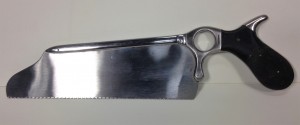
By Rob DeHart
Tennessee State Museum
Each of the last three Mercy Street episodes featured a dramatization of 19th-century surgical procedures: leg amputation, skull surgery (trephination) and a cesarean operation. In each case Dr. Foster and his assistants performed the procedures in non-sterile conditions and yet the patients survived. The first was a fairly common occurrence during the Civil War, but the second, the survival of the patients, was much more challenging.
 Standards of cleanliness in Civil War hospitals were very low compared to today’s standards. Surgeons moved from patient to patient without cleaning medical instruments and bandages were sometimes reused rather than discarded. Insufficient laundry services meant that patients rarely changed gowns. Under these conditions infection and disease spread rapidly, affecting patients, surgeons and nurses.
Standards of cleanliness in Civil War hospitals were very low compared to today’s standards. Surgeons moved from patient to patient without cleaning medical instruments and bandages were sometimes reused rather than discarded. Insufficient laundry services meant that patients rarely changed gowns. Under these conditions infection and disease spread rapidly, affecting patients, surgeons and nurses.
But with so many patients, doctors were able to experiment with different treatments. One of those was to apply a compound containing bromine with its antiseptic properties to fight the bacteria that caused gangrene in wounds. Cleaning surgical instruments in chlorinated water also helped stop the spread of bacteria in hospitals. At the beginning of the war, death from wound infection following amputation was as high as 50 percent, but it became a small threat by the end of the war, thus it was one of the war’s medical success stories.

Amputations of arms and legs was the prescribed treatment for most bullet wounds because it prevented the infection in the wound from spreading to the rest of the body. The numerous amputations performed during the war ‒ 30,000 by the Union Army alone ‒ saved the lives of many soldiers. In Mercy Street’s third episode, Dr. Foster decides this is the best course of action to save a young Confederate soldier.
In one of the most dramatic medical scenes in Mercy Street, Dr. Foster drills into a patient’s skull to relieve pressure on the brain. The practice dates back to ancient times but was rarely successful because unsterilized instruments introduced into the brain cavity led to infections. Most documented cases from the Civil War show patients initially improving, then dying a couple of days later from infections.
Nonetheless, as Mercy Street demonstrates, the Civil War provided surgeons with opportunities to document diverse cases, try new procedures and lay the groundwork for the incredible medical advances that would occur in the ensuing decades.
Mercy Street airs 9 p.m. Sundays through Feb. 21, with a midweek encore most Thursdays at 9 p.m.
Rob DeHart is a curator at the Tennessee State Museum in Nashville where he specializes in technology and cultural history. DeHart received his M.A. in public history from Middle Tennessee State University and is a peer reviewer for the American Alliance of Museums.